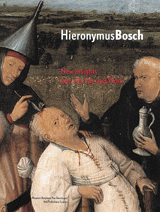
Klein 2001
“Dendrochronological Analysis of Works by Hieronymus Bosch and His Followers” (Peter Klein) 2001
[in: Jos Koldeweij, Bernard Vermet and Barbera van Kooij (eds.), Hieronymus Bosch. New Insights Into His Life and Work. Museum Boijmans Van Beuningen-NAi Publishers-Ludion, Rotterdam, 2001, pp. 120-131]
The author first gives a brief explanation about the dendrochronological method. Being based on the biological examination of the wood on which panels have been painted (mostly this wood was Baltic oak in the Netherlands from the fifteenth to the seventeenth century), dendrochronology is able to approximately ascertain the felling date of the trees that were used. By comparing these results with dated panels researchers have learned that usually there was a delay of two to eight years between the felling of the tree and the completion of the painting. Explicitly Klein warns of the fact that the felling date and the storage time of the wood afterwards can only be taken as points of reference and should not be regarded as irrefutable facts.
In the course of the years Klein has subjected a great number of panels by Bosch and his followers to a dendrochronological examination. The results of this are offered here in a number of appendixes. The most striking conclusions are that the Escorial Crowning with Thorns panel can only have been painted after 1525 and so is not a Bosch original. The same goes for the Rotterdam Wedding at Cana panel which can only have been painted after 1553. It has also become clear that the Rotterdam Pedlar tondo, the Paris Ship of Fools panel and the Washington Death of a Miser panel have been painted on wood from one and the same tree. Furthermore, in these cases the course of the annual rings and the direction of growth correspond. Because all these panels are very thin, it is not impossible that once they have been the front and back sides of the wings of a triptych and that they have been split, resulting in three different panels. This does not constitute irrefutable proof, though, as the correspondence of the annual rings and of the direction of growth could also have resulted from the fact that the panels were cut side by side from the same tree.
Regarding the hypothesis that the panels in Paris and Washington were once the other sides of the Rotterdam tondo, this last sentence (it is also the last sentence of Klein’s contribution) is important. However, it has been largely neglected in the literature about Bosch.
[explicit]